December 1, 2023
Air Date: December 1, 2023
FULL SHOW
SEGMENTS
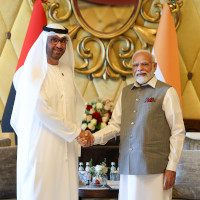
Corporate Coopting of COP28?
/ Ben StocktonView the page for this story
Leaked documents from the team leading the COP28 climate talks now underway in Dubai point to corporate coopting of the UN climate negotiations. COP President Sultan Al Jaber is also CEO of the UAE national oil company Adnoc, which according to the internal documents has used the COP process to try to cut oil and gas deals with companies and countries. Ben Stockton of the Centre for Climate Reporting, which partnered with the BBC to verify and review these leaked documents, joins Host Steve Curwood to discuss. (13:01)

Beyond the Headlines
/ Peter DykstraView the page for this story
This week, Living on Earth Contributor Peter Dykstra joins Host Jenni Doering to share some good news about regulations on PFAS “forever” chemicals. Also, a new freshman dorm at Creighton University in Omaha, Nebraska uses updated rooftop solar thermal technology to heat water. And in history, they look back to a major Alaska public lands bill that protected 100 million acres in 1980. (04:33)
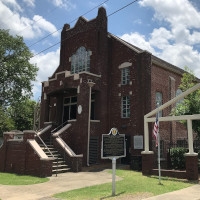
Environmental Racism in Birmingham
/ Vernon LoebView the page for this story
In North Birmingham, Alabama, racist zoning practices and industrial coke production have plagued Black communities for decades. Despite a growing focus on environmental justice from the federal government, it’s yet to be clear how new funds will help the communities in North Birmingham. Host Steve Curwood speaks with Vernon Loeb, the Executive Editor of Inside Climate News, about what he found during a reporting trip there. (14:16)
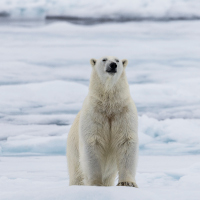
Bacon Bear
/ Mark Seth LenderView the page for this story
Smell is an ancient and powerful sense, and for Living on Earth’s Explorer in Residence Mark Seth Lender, it evokes potent memories and an encounter with a hungry polar bear. (02:45)
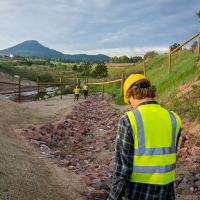
Deep-Freezing to Thwart Extinction
View the page for this story
Scientists are turning to high tech solutions to preserve genetic diversity of endangered species, including biobanking with frozen cells and living tissues. A new project involving the U.S. Fish and Wildlife Service, the nonprofit Revive & Restore, and partners aims to biobank 24 endangered mammals to start. Pete Miraglia of Revive & Restore joins Host Jenni Doering to explain the science of using biobanked material to restore healthy populations of black-footed ferrets, Mexican wolves and more. (12:11)
Show Credits and Funders
Show Transcript
231201 Transcript
HOSTS: Steve Curwood
GUESTS: Vernon Loeb, Pete Miraglia, Ben Stockton
REPORTERS: Peter Dykstra, Mark Seth Lender
[THEME]
CURWOOD: From PRX – this is Living On Earth.
[THEME]
CURWOOD: I’m Steve Curwood
DOERING: And I’m Jenni Doering.
Leaked COP28 documents point to corporate co-opting of the UN climate process.
STOCKTON: Adnoc and Masdar are basically given advance warning that these bilateral meetings are going to happen and are given the opportunity to submit talking points, and it's often about oil and gas projects that are going on or that they would like to do with those countries.
CURWOOD: Also, how storing rare animal tissues can help wildlife conservation and fight extinction in a warming world.
MIRAGLIA: Once you can create stem cells you can do research on them. You can look at disease resistance, you can look at climate change resistance and many other aspects of their genetics that aren't really possible when you try to just work on animals themselves.
DOERING: Plus fighting for environmental justice in North Birmingham, Alabama.
CURWOOD: We have that and more, this week on Living on Earth. Stick Around!
[NEWSBREAK MUSIC: Boards Of Canada “Zoetrope” from “In A Beautiful Place Out In The Country” (Warp Records 2000)]
[THEME]
Corporate Coopting of COP28?
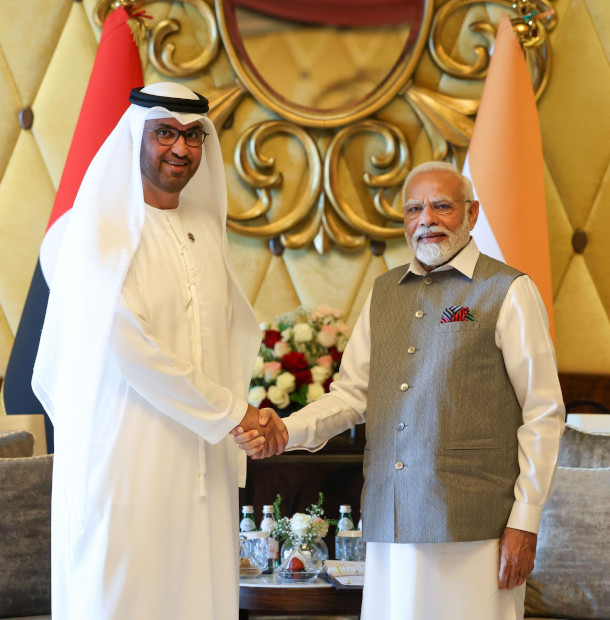
Leaked documents allege that ahead of COP 28, COP President Sultan Al Jaber used bilateral meetings with leaders from around the world to promote his companies’ commercial interests. He is pictured here with India’s Prime Minister Shri Narendra Modi in July 2023. (Photo: MEAphotogallery, Flickr, CC BY-NC-ND 2.0)
DOERING: From PRX and the Jennifer and Ted Stanley Studios at the University of Massachusetts, Boston this is Living on Earth. I’m Jenni Doering.
CURWOOD: And I’m Steve Curwood.
Leaked documents from the team leading the COP28 climate talks now underway in Dubai allegedly confirm the worst fears of critics of Sultan Al Jaber, the host country’s president for this UN Climate Summit. Al Jaber is also the UAE’s climate envoy, chair of the nation’s renewable energy company Masdar, and CEO of Abu Dhabi National Oil Company, or Adnoc. And according to the internal documents furnished by a whistleblower to the Centre for Climate Reporting and the BBC those UAE companies have used the COP process to advance their own interests. This included pushing for expansion of the UAE’s fossil fuel extraction business even as UN climate negotiators consider a phaseout of fossil fuels to keep crucial climate protection goals within reach. Ben Stockton is an investigative reporter for the UK-based Centre for Climate Reporting which partnered with the BBC to verify and review these leaked documents. Ben, welcome back to Living on Earth!
STOCKTON: Hi, Steve, thanks for having me back.
CURWOOD: So, what are these leaked documents revealed here? What are the allegations?
STOCKTON: Well, the allegations are quite simple, really, that Al Jaber, as COP 28 President, has used his role as head of this major UN Climate Summit and the meetings that he's been attending with foreign governments to essentially plan to lobby on behalf of the commercial interest of the two companies that he's involved with running, Adnoc and Masdar. And from the documents we've seen, they are essentially talking points that are included in briefings ahead of meetings with foreign officials. And basically, we've been able to get some insight on the way that this process works, which is Adnoc, the oil company, and Masdar are basically given advance warning that these bilateral meetings are going to happen and are given the opportunity to submit talking points, which are essentially things that the company would like Al Jaber to raise in these meetings. And, and it's often about oil and gas projects that are going on or that they would like to do with those countries.
CURWOOD: So these allegations are saying that there are commercial interests that are intertwined with the COP 28 presidency and process, if I hear you correctly.
STOCKTON: That's right. And the UNFCCC, which is the UN body which oversees the COP process, actually has rules in place intended to ensure the impartiality of the COP presidency. So the COP presidency is actually not supposed to represent any national interest, they're supposed to be impartial, let alone commercial interests, which is obviously the, the highly unusual situation that we've we've ended up in today.
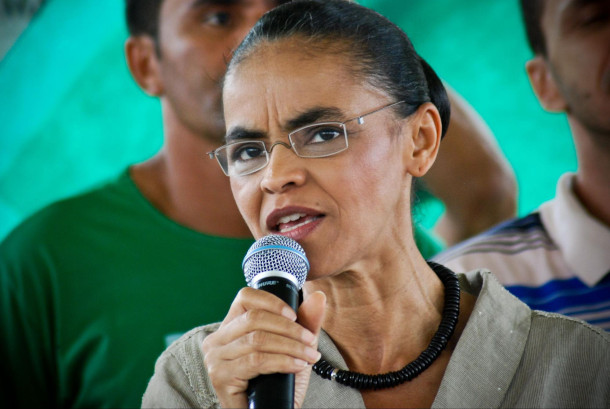
Brazil’s climate minister, Marina Silva. Leaked briefings suggest that Al Jaber planned to further commercial discussions between Adnoc, the UAE oil company, and the Brazilian petrochemical company Braskem during a meeting with Minister Silva. (Photo: Talita Oliveira, Flickr, CC BY 2.0)
CURWOOD: Now, the UAE might say that well, Masdar, the renewable energy business that they have, well, maybe they're sort of squeezing the rules a bit. But isn't this what the planet needs?
STOCKTON: I think that is certainly an argument that they may make. But it all goes back to these UNFCCC rules, which are supposed to demand impartiality. And, you know, Masdar is not necessarily doing everything that perhaps experts would want it to do in terms of how it is approaching the climate crisis. And so I think there are real concerns here about commercial interests influencing the summit in a way that doesn't align with the UNFCCC's internal processes.
CURWOOD: So talk to me about some of the details of these talking points. What were Adnoc and Masdar hoping to accomplish in these bilateral meetings?
STOCKTON: Yeah, so the talking points typically includes the value of sales and trading that Adnoc does with those countries. And you know, this can be, you know, hundreds of millions of dollars, if not billions of dollars. And then they also occasionally get into more specific details. So for example, we saw a briefing for a meeting that Al Jaber was set to hold with Marina Silva, who is the Minister for Climate from Brazil. And it appears from that briefing that he planned to actually try and push for Adnoc's bid for a major Brazilian petrochemicals company called Braskem. There are also other examples of Adnoc explaining in the talking points of its strategic partnership with China, and raising the possibility of exploring more international gas projects. Similarly, the talking points in a briefing for a meeting with Egypt mentioned that Adnoc stands ready to support the supply of petrochemicals to the country. So there really is quite an extensive level of detail within these documents. And I think that's really what has shocked so many people.
CURWOOD: I believe you have what, 150, documents, emails, various things like that. Talk to me about one that just made your eyes pop.

Talking points for a briefing for a meeting with Egypt stated that Adnoc, the oil company Al Jaber heads, is ready to support the supply of petrochemicals to the country. (Photo: Yulia Sanchez, Flickr, CC BY-NC-ND 2.0)
STOCKTON: I think one particular document that really stood out was the briefing prepared ahead of the meeting with Marina Silva, the Brazilian climate minister. I think that because that really particularly related to ongoing commercial discussions that are being had between Adnoc and a Brazilian petrochemicals company called Braskem. And it was very clear in that briefing, that Al Jaber was planning to ask for the Brazilian government support in that deal, and actually appears to have planned to ask to have Silva facilitate a call with the appropriate minister to kind of continue the discussion about that. And so that really stood out as being a particularly egregious briefing out of the ones that, you know, the more than 150 pages that I've seen during the course of this reporting.
CURWOOD: And by the way, to what extent did this relate to the vast offshore resources that Brazil has that have so far not been exploited, but there's an enormous amount of oil down there?
STOCKTON: You know, the briefing didn't directly reference that. But as we saw across all of these briefings that mentioned Adnoc, the company really was looking to exploit the natural resources that are still available around the world. And I think one particular phrase that really stood out, that was actually included in a number of the briefings, was this phrase that really seems to epitomize Al Jaber's views on the climate crisis, which is that "there is no conflict between sustainable development of any country's natural resources, and its commitment to climate change." And that really seems to encapsulate this idea that if a country has natural resources, then it should be able to use those in order to develop its economy. And, you know, plenty of people would say that that is at odds with what we need to do to abate climate change.
CURWOOD: Now, these were talking point documents. To what extent do you have evidence that the meetings actually took place, and the outlines of these deals were offered?
STOCKTON: Sure, yeah. I mean, that was a very tricky part of the investigation. Some of these meetings, the COP 28 team has publicized on its Twitter feed. We were able to get some insight into what was raised in some of these meetings. So for example, we were able to confirm that on at least one occasion, a country followed up on the commercial interests that were raised during a meeting. I also spoke to someone who had knowledge of discussions in a meeting with another country who said that Adnoc interests were raised in that meeting as well. But beyond that, it you know, these are diplomatic meetings, it's very difficult for us as reporters to get insight on those. Of course, we asked the COP 28 team about these meetings and about these briefings. And they didn't deny that Al Jaber was using bilateral meetings to raise commercial interests. But they did tell us that, you know, private meetings are private and they won't comment on them.

Vast amounts of offshore oil remained untapped in Brazil. Several of Al Jaber’s leaked briefings stated, “there is no conflict between sustainable development of any country's natural resources and its commitment to climate change." (Photo: A. Davey, Flickr, CC BY-NC-ND 2.0)
CURWOOD: Now, as you've made your rounds as a reporter about this, what do advocates of dealing with climate disruption say about this situation?
STOCKTON: I think the reaction really has been one of kind of shock and astonishment. We have heard, former Vice President Al Gore, who has been quite vocally critical of Al Jaber's COP 28 presidency, and he described it as some of the worst fears of those who criticized his appointment really kind of coming to fruition and described it as utterly appalling. Christiana Figueres, who is the former executive secretary of the UNFCCC, she actually said that the COP team had been caught red handed. And that this will hopefully put so much public scrutiny on the way that that team operates that she hopes that they will step up to the challenge, not only that team, but also the entire world. You know, the UNFCCC has said that this is really a momentous COP and and a turning point. And many people have said that we really can't afford to have a "lost COP," and the hope is that, you know, revelations like this, and many of my other colleagues across the media have been doing, will really spur action at these talks.
CURWOOD: Science says that this is a critical moment in trying to have a more livable climate, and that we need to be reducing the production of fossil fuels and related emissions. Al Jaber says that his company is planning to expand production and your leaked documents would allege that he's doing this work with countries around the world. What do you think his position in this UN Climate Summit of advancing fossil fuels yet at a time when they need to be reduced, what do you think the impact is going to be?
STOCKTON: I think that's one of the kind of great questions hanging over this COP. We do know that Al Jaber has been a big advocate for a phase down rather than a phase out of fossil fuels. And that's actually something that's mentioned in the briefing documents that we saw. They actually prepared a kind of answers for a hypothetical Q&A that might happen around the UN General Assembly, when Al Jaber was in New York in September. And they actually go into a little bit more detail about why they advocate for a phase down rather than a phase out. And he says that it will allow for some fossil fuels to still be used with their emissions abated or offset. I think there are a number of experts who are concerned about whether we have the technological ability to be able to do that yet. And really, you know, Al Jaber's view on a phase down is at odds with the UN Secretary General who has called for a complete phase out and is saying that a phase out is increasingly urgent. And so it does seem that Al Jaber's views on this are at odds with at least some people. And what you say about Adnoc is absolutely right, that within the short term, they are ramping up production capacity, which really appears to be looking to capitalize on some of the energy security issues that have been presented by the war in Ukraine. And so we do see the actions of Al Jaber's as oil company, at least in the short term, certainly being at odds with what experts are telling us must happen.
CURWOOD: There's a range of response to Al Jaber, from outrage to cautious optimism that somehow this will work to have a successful COP. How successful do you think that this Conference of the Parties can be with Al Jaber at the helm?

Former Vice President Al Gore said the leaked documents confirmed the worst fears of those concerned about Al Jaber’s COP 28 presidency. (Photo: Center for American Progress, Flickr, CC BY-ND 2.0)
STOCKTON: I think it's yet to be seen, really. Lots of people, in particular Kerry, are supportive of his COP presidency, and a number of people see him as someone who can bridge the gap between the fossil fuel industry and climate advocates. He is certainly someone who has a foot in both camps. And many people believe that the fossil fuel industry should be at the table and part of these talks. I think there is a difference between being at the table and being at the head of the table, which is where Al Jaber currently finds himself. And you know, quite rightly, there are a number of people who are very concerned about how successful this COP can be under an individual who has so many vested interests in the success of the fossil fuel industry.
CURWOOD: Ben Stockton is an investigative reporter for The Centre for Climate Reporting. Thanks, Ben.
STOCKTON: Thanks so much, Steve.
CURWOOD: At a press conference on the eve of COP28, Sultan Al Jaber flatly denied the claims.
AL JABER: These allegations are false. Not true, incorrect, and not accurate. And it's an attempt to undermine the work of the COP 28 presidency.
CURWOOD: But Al Jaber went on to confirm he has been in discussions with countries and companies and feels he’s gotten mixed signals about the ethics of that.
AL JABER: Every meeting I have conducted with every government, or any other stakeholder has always been centered around one thing, and one thing only. And that is my COP 28 agenda, and how we can collectively, for the first time ever adopt a mindset that is centered around implementation and action to keep 1.5 within reach. Now, sometimes, I am told you need to engage with governments and with oil and gas companies, to put pressure and sometimes I'm told you can't do that. So we're damned if we do. We're damned if we don't.
CURWOOD: COP28 president Sultan Al Jaber.
Related links:
- Centre for Climate Reporting covers the story
- BBC reports on the story
- Al Jaber denies allegations (see 1:15:00)
[MUSIC: Grover Washington, Jr., “Minister Magic” on Minister Magic, Motown Record Company L.P., UMG Recordings, Inc.]
DOERING: Coming up, North Birmingham, Alabama is burdened by the twin toxic legacies of industrial pollution and white supremacy. That’s just ahead. Stay tuned to Living on Earth.
ANNOUNCER: Support for Living on Earth comes from Sailors for the Sea and Oceana. Helping boaters race clean, sail green and protect the seas they love. More information @sailorsforthesea.org.
[CUTAWAY MUSIC: Jan Luna, “Winter Wonderland” on Joy To the World: A Christmas Celebration, by Felix Bernard & Dick Smith/arr. Jan Luna, Putumayo World Music]
Beyond the Headlines

The Environmental Protection Agency has proposed new drinking water standards for six forever chemicals. (Photo: r. nial bradshaw, Flickr, CC BY 2.0)
CURWOOD: It’s Living on Earth, I’m Steve Curwood.
DOERING: And I’m Jenni Doering, and it’s time now for look beyond the headlines with Living on Earth contributor Peter Dykstra who joins us from Atlanta, Georgia. Hey there Peter, how ya doin’ this week?
DYKSTRA: I'm doing well Jenni and I hope you are too. And we're going to start out with a little collection of good news on PFAS so called forever chemicals.
DOERING: Say what good news on PFAS? Peter?
DYKSTRA: You know, PFAS is a big problem but the good news is that the big problem is being confronted more and more. For one thing, the US Environmental Protection Agency has proposed new PFAS drinking water standards. And if they're adopted, there would be just a sea change, pardon the pun, in the way the drinking water is tested and treated all over the US. There have been a lot of states that have jumped ahead of federal regulation. Most recently, the state of Minnesota, which passed some of the most comprehensive PFAS bans in all of the states. Others are soon to follow and maybe even surpass the state of Minnesota, which of course we should remember is the land of 10,000 lakes.
DOERING: Yeah they got a lot of water there, Peter so let's hope we don't pollute it. And please remind us what are some of the concerns associated with these so called forever chemicals?
DYKSTRA: Potential cancer causers, potential disruption of reproductive processes, some fairly scary things. And those scary things being confronted by good news is why we want to make sure the good news is known and out there and reported.
DOERING: Well, I'm hoping you might be able to keep the good news going for us Peter. What's next?
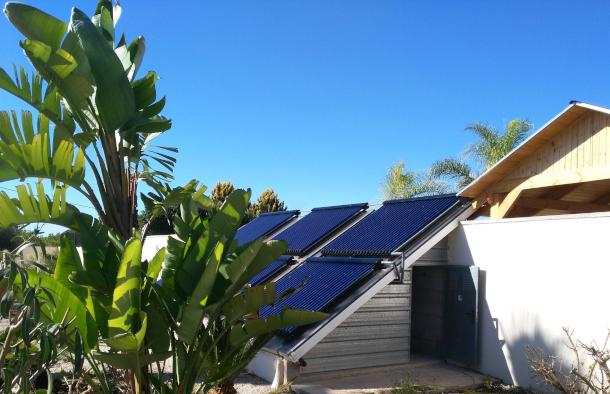
These rooftop units utilize sunlight to heat water for indoor use. (Photo: PeterVauhn, Wikimedia Commons, CC BY-SA 4.0)
DYKSTRA: This is a little bit of good news that builds on a technology that's over 40 years old. Out in Creighton University a school in Omaha, Nebraska, there's a passive solar water heating system going on the roof of a new 400 student dorm on the Creighton campus. The energy system will warm water thermal energy can be a help in heating water that's used by the 400 students. It's a freshman dorm, so the freshmen get the good stuff first, sorry, upperclassmen. It becomes very, very clear that these vacuum sealed glass tubes are converting the sun's energy into heat instead of converting it to electricity. It's a carbon free system as well. But here's something to build on- more than 40 years ago, there was a passive solar water heating system placed by President Jimmy Carter on the White House roof. It was good for show, it was a nice symbol. Truth be told, it didn't do a whole lot they're basically small aluminum bathtubs that let the sun heat water, it was then run through the White House to help save a little bit on hot water heating costs.
DOERING: Well, so this sounds like maybe what's old is new, Peter?
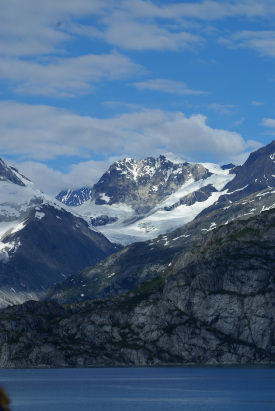
523,000 acres were added to Glacier Bay National Park with the 1980 Alaska National Interest Lands Conservation Act signed by President Jimmy Carter. (Photo: Randy Roach, Wikimedia Commons, CC BY-SA 2.0)
DYKSTRA: It is and we've got something from that same era, the Jimmy Carter administration to talk about in our history item this week.
DOERING: All right. Okay, go ahead.
DYKSTRA: December 2, 1980. President Jimmy Carter signed the Alaska Lands Bill, that's the nickname for the Alaska National Interest Lands Conservation Act, or a ANILCA if you want to lousy acronym. Roughly two thirds of Alaska, about 222 million acres are either owned or managed by the federal government ANILCA added 100 million acres to add up to that 222 total. That includes national parks, national wildlife refuges, preserves and other areas that help maintain Alaska as a mostly pristine state.
DOERING: Well, those public lands up in Alaska just sound amazing, Peter. I have to say I've never been but it's on my list for sure. Thanks so much Peter. Peter Dykstra is Living on Earth's contributor and we'll talk to you again next time.
DYKSTRA: All right, Jenni. Thanks a lot, talk to you soon.
DOERING: And there's more on these stories on the Living on Earth website that's LOE dot ORG.
Related links:
- Environmental Health News | “PFAS: EPA Releases Proposed Drinking Water Standards for Six “Forever Chemicals””
- Environmental Health News | “Minnesota Enacts Nation’s Broadest Ban of “Forever Chemicals””
- Inside Climate News | “A New Solar Water Heating System Goes Online as Its Developer Enters the US Market”
- Learn more about the Alaska National Interest Lands Conservation Act (ANILCA)
[MUSIC: Grover Washington, Jr., “Black Frost” on Minister Magic, Motown Record Company L.P., UMG Recordings, Inc.]
Environmental Racism in Birmingham
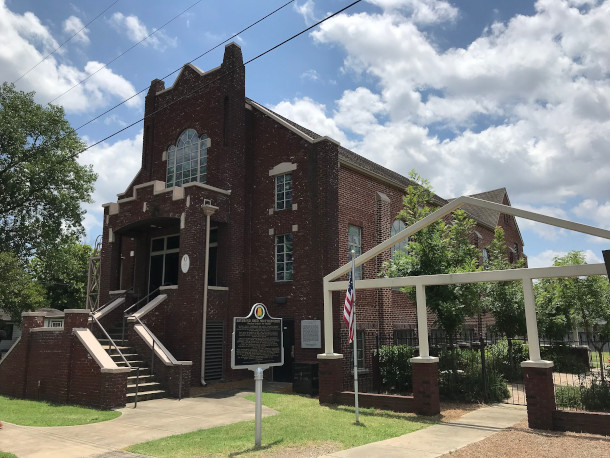
The Bethel Baptist Church in North Birmingham and the memorial to the parsonage that was bombed on Christmas night, 1956. (Photo: Heather Cowper, Heatheronhertravels.com, Flickr, CC BY-NC 2.0)
CURWOOD: The Biden Administration has made advancing environmental justice a priority and just recently announced $2 billion in Inflation Reduction Act funding for EJ and climate justice grants. These dollars are expected to help mitigate climate risks like extreme heat, install pollution monitoring systems, and clean up communities that have borne the brunt of industrial pollution. But it is yet to be clear how these funds will benefit communities like North Birmingham, Alabama, where racist practices and industrial coke production have plagued Black communities for decades. Vernon Loeb is the Executive Editor of our collaborator Inside Climate News and he reported about the environmental justice struggles in North Birmingham. Welcome to Living on Earth, Vernon!
LOEB: Thanks so much, Steve. It's great to be here.
CURWOOD: So first off, why don't you describe the area of North Birmingham for us and the industries that have been located there?
LOEB: Yeah. I think the most striking thing about this area in North Birmingham, which is now called the 35th Avenue Superfund site, is that it's actually three entire neighborhoods inside the Superfund site. Most Superfund sites are sort of dump sites out in the middle of nowhere. This one consists of three predominantly Black neighborhoods, really all-Black neighborhoods in North Birmingham, that are surrounded by polluting industries, primarily steel, coke and cement plants. People don't know that Birmingham was the Pittsburgh of the South up until the 50s, or 60s or even 70s, I guess. And these neighborhoods, Fairmont, Collegeville, and Harriman Park, were cheek to jowl with three major coal plants, additional steel plants, dozens of plants. And North Birmingham was a thriving part of the city that's now pretty much completely gone. And what you just have are these sort of orphaned neighborhoods surrounded by these industrial facilities, many of which are now closed.
CURWOOD: When I think of Birmingham, I think of the civil rights movement as well. What did this neighborhood have to do with that?
LOEB: It's so ironic that this Superfund site is where it is, because it includes Bethel Baptist Church, which is a national historic landmark. And it was the place where Fred Shuttlesworth was the pastor from, I think, 1955 until 1961. He was one of the leaders of the civil rights movement, and really the leader of the movement in Birmingham. And his parsonage, his home next to the church, was bombed by the Klan on Christmas night, 1956. He was at home, he was almost killed. And so this historic church and a kind of monument to the parsonage -- the parsonage was destroyed, but there's sort of a superstructural monument to it -- is now within the Superfund site. So it's a very powerful place, and to be the site now of a kind of environmental justice reckoning by the EPA, all these years after the civil rights movement in Birmingham is really incredible.
CURWOOD: Talk to me about the racial practices there. How did redlining and zoning influence the pollution that locals were exposed to in this Black neighborhood?
LOEB: Yeah, well, this really is sort of the archetypal environmental justice community, because up until the 1950s, the neighborhoods themselves were zoned Black. They were zoned for Black people. It was about as racist as one could possibly imagine. And when Black people started to integrate middle class white neighborhoods, the Klan and others bombed, you know, large numbers of Black houses to keep Black people from moving into those neighborhoods. So this really is about, as I say, archetypal, racist environmental justice community, as one can imagine in this country: Black-zoned neighborhoods, surrounded by the most polluting industrial facilities you can imagine.
CURWOOD: So North Birmingham has this toxic social legacy. And now also today, a toxic health situation, a Superfund site. What kinds of substances are there that endanger the population?
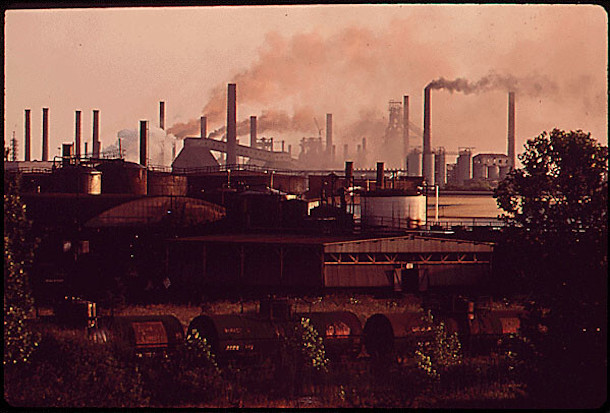
A June 1972 photograph of the U.S. Steel plant in Birmingham, Alabama. (Photo: LeRoy Woodson for EPA, Dystopos, Flickr, CC BY-NC 2.0)
LOEB: Well, it was, it became a Superfund site around 2014, when it was discovered that the soil, the topsoil that had been spread on the lawns of over 600 homes in these three neighborhoods had come from the surrounding coke plants. And it was laced with lead, and arsenic, and other very toxic elements. And now, the EPA has pretty much dug up the dirt and replaced it with clean topsoil on about 650 lawns. So the remediation of the Superfund site, per se, is pretty much done. What remains to be done is something for the neighborhoods themselves that have really fallen on ill repair because of their surroundings and because of this legacy of toxic pollution.
CURWOOD: What have been the health concerns there? I mean, stuff like coke has benzopyrene, all kinds of things that are known to lead to cancer.
LOEB: Yeah. When you go around the neighborhoods and you talk to residents, everybody will tell you about the cancer in their family. And coke is one of the most toxic substances. It's actually baked coal that's used in blast furnaces for making steel. And the emissions from a coke plant are considered human carcinogens. So these neighborhoods were surrounded by the dirtiest, most polluting facilities one can imagine. You know, as we know, it's very hard to prove causation, right? It's very hard to prove that the emissions from a coke plant half a mile from your house caused the three generations of cancer in your family. But you know, if you spend enough time in these neighborhoods and you talk to enough people, the anecdotal associations really become overwhelming. And certainly the people who live in these neighborhoods are absolutely convinced that these polluting coke plants and steel plants around the neighborhoods devastated the health of their, of their loved ones and their families.
CURWOOD: What kind of efforts have been made by public health researchers to document the health effects of these polluting plants?
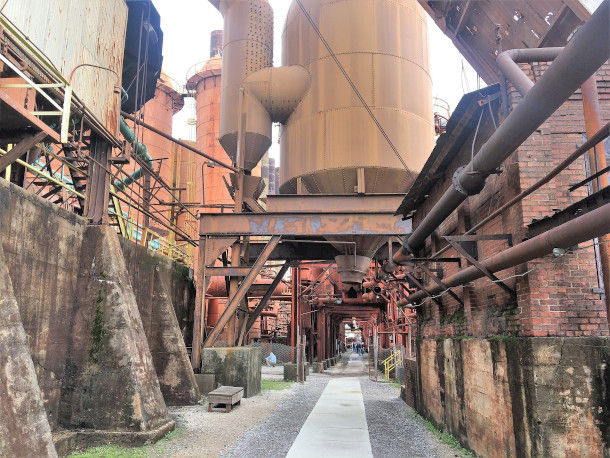
Sloss Furnaces National Historic Landmark in Birmingham, Alabama commemorates the steel and iron industry that was once dominant in the city but resulted in harmful air, land, and water pollution there. (Photo: David Wilson, Flickr, CC BY 2.0)
LOEB: You know, I don't think there have been extensive public health studies of the area. One thing that really caught my eye this summer when I was down there, and I was told about this by residents and by activists and by attorneys at the Southern Environmental Law Center, is the EPA decided about a year or two ago to do a cumulative impact study, looking at the cumulative impact of decades of pollution on these neighborhoods as a sort of environmental justice case study. And that really, I think, to some extent, spoke to the priority that the Biden administration has assigned to environmental justice. And I know that people in the neighborhood were, you know, really looking forward to what the results of this study were going to be. It came out a couple of months ago, and I was a little bit disappointed. It was done by the EPA Inspector General. And so it wasn't a policy office, it wasn't the Superfund program office with, you know, millions of dollars at its disposal. It was the Inspector General basically making recommendations for procedural reforms at the agency. And the conclusion was that the four major EPA programs that had been working in the area -- the water program, the air pollution program, the land pollution program, the Superfund program -- were completely siloed and never talked to each other and never really even considered the cumulative impact of, say, air pollution and ground pollution on the residents. So that is now something the EPA is trying to craft metrics to get at, you know, to resolve in the future. If you're going to be working in a neighborhood like this, you really need to look at the public health implications across all disciplines, be it air, be it water, be it land. And so that's one thing that's come out of this.
CURWOOD: So now, what's been done at this point to heal and, and rebuild this community from this toxic legacy of pollution and disinvestment?
LOEB: Well, as I say, the lawns themselves have been remediated. So most people no longer have to wake up every day and worry about their kids going out and playing in arsenic- and lead-laced dirt in their front yards. And these are small yards, these are small homes. The Southern Environmental Law Center continues to litigate against Bluestone Coke, which is one of the very nearby coke plants. The plant has been closed because of all the pollution violations that are outstanding that it has yet to deal with. And it continues to pollute a nearby stream, and that's what the ongoing litigation is about. So there are ongoing efforts to clean up Bluestone Coke. You know, there isn't a whole lot happening in these neighborhoods, sadly, and they are fading as, you know, I, I spoke to one of the neighbors, one of the leaders of a community group in one of the neighborhoods who said to me, North Birmingham is gone, there's just not a whole lot left here to try to save. And that's why this person believed that the residents there deserved to have their homes purchased at estimated fair market value, so they could, you know, move somewhere else.
CURWOOD: Yeah, let's talk about the options now for the community. You have those who say, Give us money so we can move elsewhere and reestablish. And then there are those who say, Come on, let's clean this up and make it possible for us to stay. And then I imagine there are some folks who are in the middle. So how does that play in terms of the research that you did while you were working on the story?
LOEB: Well, you know, I think there's still resources in the community to build upon, you know, beginning with Bethel Baptist, which is still a vibrant congregation, but a number of the homes are vacant and in disrepair. There have been fires, the streets need help. It feels like a part of the city that's sort of been forgotten and it's starting to become sort of abandoned.
CURWOOD: Vernon, before you go talk to us about how this environmental justice disaster in North Birmingham squares with the environmental justice initiatives in the, in the Biden administration. I mean, to what extent do you think the folks there in North Birmingham have benefited from the environmental justice promises made by the administration?
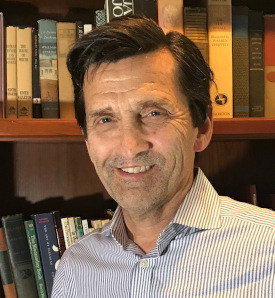
Vernon Loeb is the Executive Editor of Inside Climate News. (Photo: Courtesy of Vernon Loeb)
LOEB: I don't think they've benefited at all yet. In fact, the 2021 Infrastructure Bill provided 5 billion new dollars for the Superfund program and for, quote unquote, "brownfields," that is, redevelopment of these old industrial pieces of land in cities. So there's certainly money in the Superfund program now, if somebody wanted to allocate it to these neighborhoods to again, beyond just replacing the dirt on their lawns, repaving streets, rebuilding homes and so forth. Building community centers, doing all the things that are, you know, part of the playbook for revitalizing neighborhoods. That could happen there, and it hasn't happened there yet. And I think, you know, obviously, that's what a lot of the residents in these neighborhoods are waiting for, you know, those kinds of dollars to start coming home to that Superfund site. Fascinating aspect of this site, in 2014, when the EPA started moving to include the 35th Avenue Superfund site on the so-called national priorities list, which is a listing of the most hazardous waste sites in the country, those eligible for the most funding. An executive of one of the nearby coke plants and his attorney actually bribed a state legislator to have him try to keep the 35th Avenue Superfund site off the national priorities list. And they succeeded, it's still never been added to the list. Those three people went to jail. So there was actually, you know, a bribery case that grew up around this Superfund site, as people endeavored to keep it off that national priorities list and keep it from getting additional funding. And to this day, it's never gotten any additional funding.
CURWOOD: So Vernon, what's the overall mood in Birmingham -- Black and white, about trying to deal with these horrible problems in North Birmingham?
LOEB: You know, it's certainly not the city from the 50s or 60s. It's not the city it was during the Civil Rights Movement. It has a highly respected progressive Black mayor now in Birmingham. There is, you know, considerable civic infrastructure there. There were multiple community and environmental groups at work on behalf of the residents of the Superfund site neighborhoods. And there's an office of the Southern Environmental Law Center in Birmingham, and the Southern Environmental Law Center is a real powerhouse institution, the lawyers from that law center don't mess around. I mean, they are really aggressive and they know environmental law. They are all over Bluestone Coke. And so I do think there is more than a little cause for optimism in Birmingham that the Biden administration's rhetoric about environmental justice can become a reality on some level.
CURWOOD: Vernon Loeb is the Executive Editor of our collaborator, Inside Climate News. Thanks so much for taking the time with us today.
LOEB: It was great to be here. Thank you.
Related links:
- Find the article on the Inside Climate News website
- About Vernon Loeb, Executive Editor of Inside Climate News
[MUSIC: Freddie King, “Ain’t No Sunshine” on Texas Cannonball, Capitol Records]
DOERING: Just ahead, how deep-freezing samples from rare species can help lower the odds of extinction. Keep listening to Living on Earth.
ANNOUNCER: Support for Living on Earth comes from Friends of Smeagull the Seagull and Smeagull’s Guide to Wildlife. It’s all about the wildlife right next door to you! That’s Smeagull, S - M - E - A - G - U - L - L, SmeagullGuide.org.
[CUTAWAY MUSIC: Eric Tingstad, “Tennessee Rain” on Mississippi, by Eric Tingstad, Cheshire Records]
Bacon Bear
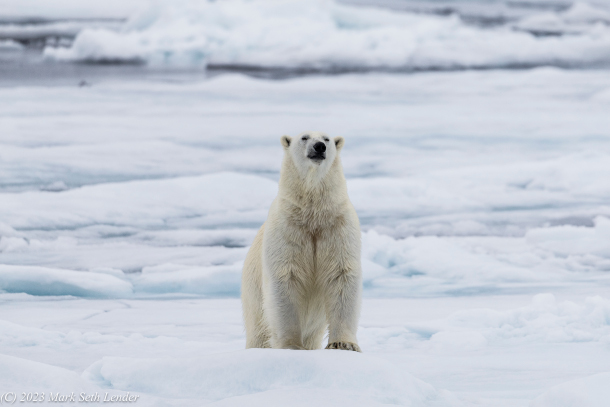
Polar bear stands, looking towards Mark Seth Lender’s research vessel. (Photo: © Mark Seth Lender)
DOERING: It’s Living on Earth, I’m Jenni Doering
CURWOOD: And I’m Steve Curwood.
Some key features of life on Earth evolved long ago, including the sense of smell. It goes back at least half a billion years, when our ancestors still swam in the sea. Living on Earth’s Explorer in Residence Mark Seth Lender hasn’t been around for quite that long but some heavenly smells still take him back.
Bacon Bear
© 2023 Mark Seth Lender
All Rights Reserved
When it’s Bearded Iris time, those blooms wide as the spread of your hand. I breath. And close my eyes… That fragrance impossible to describe and then… The longing. For my grandparents. Their yard where bearded irises grew all along the side. For being small and safe, and free from complication.
And there I am. Right there.
Scent; Memory; Illusion; each one leads to the other.
And not just for us.
81’ 35” North Latitude, dead on 600 miles from the Pole and the cook on our research vessel is making bacon for breakfast. All the bacon. Why, I don’t know. But the cabins wreak of it. Midships. Companionways. The bridge. Even the foredeck out to the bows. And apparently beyond because -
The polar bears are coming.
All of them.
One in particular captures my attention. He’s way out there on the polar ice, wending his way toward the ship, the ice rolling under him in the swell. Closer and closer. And every few steps out comes that big, beautiful, black raspberry tongue, way down past his chin - and he inhales.
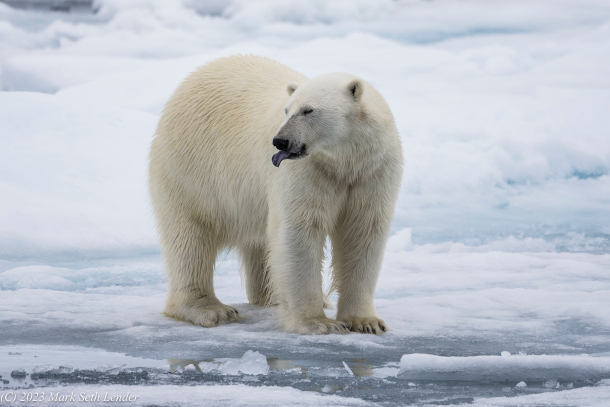
The polar bear sticks out its tongue, as if tasting the bacon smell on the air. (Photo: © Mark Seth Lender)
Ahhhhhhh…
And when he does just like me on the perfume of bearded irises, he closes his eyes.
Except for Bacon Bear the memories are being made right here.
I don’t eat bacon. Some of it is cultural. Not eating pork is the one food prohibition we are most likely to obey. Mostly, it’s because of what factory farming does to pigs. And I won’t be giving a dime to that. Nonetheless... Bacon Bear deserved to have a slab tossed out on the ice for him. And I would have. But I was not in charge, and we didn’t.
CURWOOD: That’s Living on Earth’s Explorer in Residence Mark Seth Lender. For photos of that hungry polar bear, go to our website, loe.org.
Related link:
Visit Mark Seth Lender’s website here
[MUSIC: Herb Alpert, “Rise” on Rise, Herp Albert Presents]
Deep-Freezing to Thwart Extinction

Field biologists enter a restoration site for the endangered Preble’s meadow jumping mouse (Zapus hudsonius preblei), which is only found in parts of Wyoming and Colorado. (Photo: Kika Tuff, Revive & Restore)
DOERING: Unchecked global warming could bring the extinction of more than a third of all animal and plant species by 2050, according to a recent report by the Intergovernmental Panel on Climate Change. And many species are already in decline because of habitat loss, hunting, and invasive species. Addressing those problems is key in the long run but for some species on the brink like the endangered Mexican wolf, time is already running out. So scientists are turning to high tech solutions to preserve genetic diversity, including biobanking. That’s where living cells and tissues are collected and frozen, or cryopreserved. A new partnership is in the works to biobank 24 endangered mammals selected by the U.S. Fish and Wildlife Service, which has teamed up with the US Department of Agriculture, ViaGen Pets & Equine, the San Diego Zoo Wildlife Alliance and the non profit Revive & Restore. Pete Miraglia is the deputy Director for Revive and Restore and he joins me now. Welcome to Living on Earth Pete!
MIRAGLIA: Thank you, Jenni, and thanks for having me on the show.
DOERING: So how does this partnership actually work? How do scientists collect and then share these cells and these tissues?
MIRAGLIA: Yeah, so we have a close partnership with the Fish and Wildlife Service, with the San Diego Zoo and wildlife Alliance, a company called ViaGen and USDA. And what we've done is we've created a constellation of partners that with a goal of lowering the barriers to biobanking. So making it really easy for field biologists and conservationists to collect tissue and get it cryopreserved. What that entails is we send a kit out to the field biologist, that kit is really easy to use, it comes with some instructions, and some vials. And they can very easily as part of their practice, do an air punch, and collect that tissue put it in the test tube and send it off. And a couple days later, it shows up in the lab and they generate a cell culture. And that cell culture, once it gets through its hoops and doubling times over a month or two that's cell culture gets cryopreserved. And once it's cryopreserved, we send it off to the USDA for long term cryopreservation at a federal facility.
DOERING: And of course, cryopreservation means freezing the sample. How cold is it when you freeze it?
MIRAGLIA: It's liquid nitrogen temperature, so I think it's about a minus 150 degrees Celsius.
DOERING: That's pretty cold!
MIRAGLIA: So it's not absolute zero, but it's pretty close and the idea behind getting that cold of a temperature is to cease all metabolism, all cell functions so that the cell actually just gets indefinitely preserved, as if it's a time machine, it'll go on indefinitely until you thaw it.
DOERING: So once the cells are collected and frozen, what happens next?
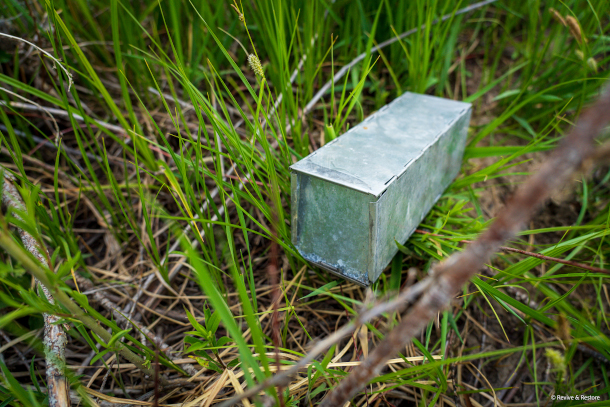
A Sherman trap commonly used to capture small mammals in scientific studies. (Photo: Kika Tuff, Revive & Restore)
MIRAGLIA: So once they're collected and frozen, you know, there's two things one is we're just trying to preserve that genetic diversity that still exists today. And if you think out into the future, what the possibilities are, while the here and now is you can do genetic studies on that material, it does represent and contains the DNA of the individual. You can also consider looking at reconstituting populations, so you could take those cells, and you can take them and make them into new individuals and that sort of process today called cloning. And that's already been demonstrated by a couple of projects that we're working on, where you can take genetic information from previous decades and bring them back into the population, that's one option.
DOERING: So tell me about the cloning that has already been done with this.
MIRAGLIA: Yeah, there's a couple of exciting projects that we're working on. One is with the black footed ferret, which is a North American mammal, and highly endangered, another one is with przewalski's horse, which is an endangered horse. And in both cases we in collaboration with the San Diego Zoo and Biogen created clones from individuals that existed decades ago. And those cell lines were frozen at the San Diego Zoo, Frozen Zoo. They were collected and frozen there. And what's really exciting is that those individuals represent genetic diversity that does not exist in the current population. So what we're trying to do there was bringing lost genetics from previous generations back into the future and into the population.
DOERING: Can you tell me a little more about the black footed ferret and the story of this individual that was cloned?
MIRAGLIA: So the success story of the black footed ferret which really spawned this biobanking initiative, took a 40 year old frozen cell line back from the 1980s okay, back when I was a kid, and at that time the black footed ferret was assumed to be extinct in the wild and miraculously, a small population was rediscovered in Wyoming. And they have since grown that population through captive breeding of that initial group of founders they found to about 300 or 400 as they exist today. And the individual that was brought back through cloning, a cell line at the San Diego Zoo does not currently have its genetics, represented in the current population. So what we've actually done is taken those genetics and brought them back in a much needed way into the genetic diversity of the current pool. And this project is still going on, we're still trying to find ways to clone more ferrets, so that once these ferrets are fertile and can reproduce, their genetics can be brought back into the population.
DOERING: Once we have this frozen cell sample or frozen tissue, how does it actually get incorporated into a living animal and created into a clone, for example?
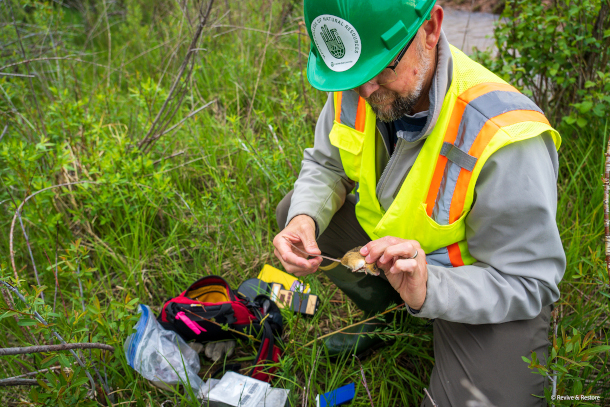
A field biologist examines an endangered Preble’s meadow jumping mouse (Zapus hudsonius preblei) captured during a population survey. The mouse is assessed and weighed to confirm health. Before the mouse is released, a small piece of skin is collected for biobanking as part of the new initiative. (Photo: Kika Tuff, Revive & Restore)
MIRAGLIA: Well, the state of the art today with cloning, and this is possible. If you have a very highly valued pet or a stallion that you really want to keep them going. What's possible today is what they call somatic nuclear transfer, which says, I'm going to take the nucleus from a skin cell, which contains the DNA of the individual and put that into an embryo. And the embryo will take it in and use that nucleus as its nucleus. And through some tricks with biotechnology, that embryo can be transferred and put into a surrogate host. And not necessarily a surrogate host for the endangered species but it could be a cousin or closely related species, and then that close related cousin can bear the offspring and those offspring will represent the genetics of that actual embryo and the nucleus of that skin cell that was offered as a donor. So in a sense, the clone represents truly represents the genetics of the individual that was frozen.
DOERING: So you mentioned that beyond cloning, there are other things that can be done with this material years down the road. Please tell me about those.
MIRAGLIA: Yeah, I mean, I think what we're talking about here is getting really on the cutting edge of biotechnology and applying it to wildlife and conservation. There's an interesting opportunity there, because what we can actually do is take these cells like for example, the cell line that comes from your skin and it is possible and has been demonstrated the mouse model to convert those cells into stem cells. They call them pluripotent stem cells, or induced pluripotent stem cells. And once you can create stem cells, you can reprogram them. And you can also get them to multiply much more rapidly and expand them well beyond what skin cells are capable of doing. And you can do research on them. You can look at disease resistance, you can look at, you know, climate change resistance, and you can look at many other aspects of their genetics that aren't really possible when you try to just work with individuals and animals themselves.
DOERING: So what are the challenges of using frozen samples of tissues?
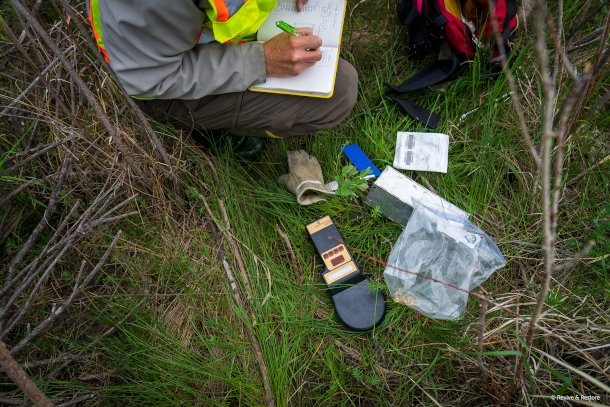
A field biologist records data during a study of the Endangered Preble’s meadow jumping mouse (Zapus hudsonius preblei). (Photo: Kika Tuff, Revive & Restore)
MIRAGLIA: I think what becomes challenging is if you go beyond mammals to other taxa, for example, consider like amphibians, birds, marine invertebrates, reptiles, insects, plants, these represent, you know, over 90% of all the other endangered species that I haven't mentioned yet. We're actively looking at solutions to these problems so that other taxa will have the same benefit as mammals and cryopreservation. And that's a pretty open field. And I think one particular area that's interesting to us or two are amphibians and plants, plants represent over half of the endangered species list, and cryopreserving plants is still in its infancy. It's been demonstrated for a number of species, but it's not widespread. Seed banking is still necessary, and it's possible but there are a number of plants that just can't be seed banked or the don't produce seeds. And amphibians also face similar challenges where if you want to be able to collect skin tissue, non lethally from a amphibian, it's very, very challenging, if you can imagine. And trying to do a cell culture for amphibians is also very challenging for mammals, you can expect to cell culture of a certain size that would be useful within you know, a month to month and a half, right. Whereas amphibians, you may have to wait almost a whole year. And over that course of that time, with that full year, there's very great opportunity for fouling and infection, and basically ruining of the cell culture. So there's a lot of work to be done there and we're exploring opportunities to do research in those areas.
DOERING: So from what I understand there are about 25 animals that your biobanking project will focus on in its pilot phase. And there are some that are already cryopreserved like the Mexican red wolf, can you please tell me about that project?

Endangered Preble’s meadow jumping mouse (Zapus hudsonius preblei) released back to its home. (Photo: Kika Tuff, Revive & Restore)
MIRAGLIA: Sure, yeah there's about 25 species that were selected through the National Office of Fish and Wildlife and they have representation across the country and across all the fish and wildlife regions. And there are a number of large mammals including Mexican wolf, the pronghorn, the ocelot and the Santa Catalina Fox. The Mexican wolf is an interesting project because they went through a bottleneck that was similar to the black footed ferret, they got down to I think about seven founders. And the Mexican Wolf is endemic to the southwest and Mexico. And recently, you know, Mexico and the United States instituted a captive breeding program, in addition to habitat protection that has brought back the wolf populations to close to 200, which is really amazing. The project that we did together with Fish and Wildlife, the Wolf Conservation Center, the Endangered Wolf Center and St. Louis Zoo was kind of unique, because we took the opportunity to actually select individuals in the population based on the highest genetic value. So if you think about it, maybe tracing back much more closely to the original founders. And there were a couple individuals frozen, that is really under the category of what we call informed biobanking, which is, I'm going to carefully select, as best I can the highest genetic value and try to bank that so that when I want to take that out of the bank, again, it is the most useful.
DOERING: So Pete, this all kind of sounds like Noah's Ark, except you don't get genetic diversity from just two animals of each species. And of course, genetic diversity is also changing with time. So what does this mean about how much cell material and genetic information you need to collect?
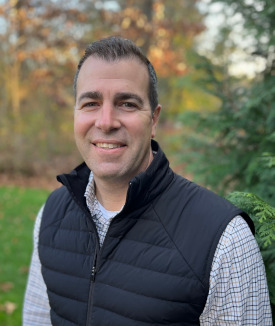
Pete Miraglia is the Deputy Director for Revive and Restore. (Photo: Courtesy of Pete Miraglia)
MIRAGLIA: Yes, the number of individuals you might consider in a more expansive pilot or a more expansive project like this can get upwards of 50 to 100 individuals per depending on the size of the existing population. So you look at two and it's like, yeah, okay, I understand what you're saying there, Noah's Ark that's how it looks, but our pilot is really just to get this started and to start making it systematic. So that every year when field biologists and Fish and Wildlife species leads go out into the field, or even do a wellness check for a captive population, we really just wanted to try to get them into the practice of it to say, "hey, this is really easy to do, I could do this every year, I just need to add an additional, you know, five or 10 minutes to my routine, do a kit tissue small tissue collection, and send it off to the lab". And you can start building your bank that way and getting up to those numbers that you might consider for a larger population that you want to preserve. And you think about this long term if we can get to those kinds of numbers as part of normal practice, you could even consider looking at how genetics is changing over time. And you could even consider using this as a tool to manage existing populations. You know, if you look at captive breeding programs where they try to manage the genetics of their populations, you could look at the genetics end of this and say, "okay, I have the materials to do the sequencing, and actually be, you know, a little more surgical and precise about which individuals I want to have reproduced". So that you can maximize the genetic diversity of the pool.
DOERING: Pete Miraglia is the Deputy Director of Revive and Restore. Thank you so much, Pete.
MIRAGLIA: Thank you, Jenni, for having us on the show was a pleasure.
Related links:
- Learn more about Revive and Restore
- Revive and Restore | “New Biobanking Partnership Safeguards the Genetic Diversity of America’s Endangered Species”
[MUSIC: The Greyboy Allstars, “What Happened to TV?” on What Happened to Television?, Knowledge Room Recordings]
CURWOOD: Next week on the show, A man walks into a bar… and comes out with a piece of nature writing.
GESSNER: And the next morning I woke up kind of groggy, and I realized I'd made a date to go off-road motorcycling with the guy I'd met the night before. And off we went, and about halfway through I went flying off the red rocks and landed, and bruised my ribs and my wrist, and I was lying on the ground and I thought “this is going to be so perfect for the article”.
CURWOOD: David Gessner on his latest book "A Traveler's Guide to the End of the World", next week on Living on Earth.
[MUSIC: The Greyboy Allstars, “What Happened to TV?” on What Happened to Television?, Knowledge Room Recordings]
CURWOOD: Living on Earth is produced by the World Media Foundation. Our crew includes Naomi Arenberg, Paloma Beltran, Josh Croom, Swayam Gagneja, Mattie Hibbs, Mazzi Ingram, Mark Kausch, Mark Seth Lender, Don Lyman, Sarah Mahaney, Aynsley O’Neill, Sophia Pandelidis, Jake Rego, El Wilson, and Jolanda Omari.
DOERING: Tom Tiger engineered our show. Alison Lirish Dean composed our themes. You can hear us anytime at L-O-E dot org, Apple Podcasts and Google Podcasts, and like us, please, on our Facebook page - Living on Earth. We tweet from @livingonearth. And find us on Instagram at livingonearthradio. And you can write to us at comments at loe dot org. I’m Jenni Doering.
CURWOOD: And I’m Steve Curwood. Thanks for listening!
ANNOUNCER: Funding for Living on Earth comes from you, our listeners, and from the University of Massachusetts, Boston, in association with its School for the Environment, developing the next generation of environmental leaders. And from the Grantham Foundation for the protection of the environment, supporting strategic communications and collaboration in solving the world’s most pressing environmental problems.
ANNOUNCER 2: PRX.
Living on Earth wants to hear from you!
Living on Earth
62 Calef Highway, Suite 212
Lee, NH 03861
Telephone: 617-287-4121
E-mail: comments@loe.org
Newsletter [Click here]
Donate to Living on Earth!
Living on Earth is an independent media program and relies entirely on contributions from listeners and institutions supporting public service. Please donate now to preserve an independent environmental voice.
NewsletterLiving on Earth offers a weekly delivery of the show's rundown to your mailbox. Sign up for our newsletter today!
 Sailors For The Sea: Be the change you want to sea.
Sailors For The Sea: Be the change you want to sea.
 The Grantham Foundation for the Protection of the Environment: Committed to protecting and improving the health of the global environment.
The Grantham Foundation for the Protection of the Environment: Committed to protecting and improving the health of the global environment.
 Contribute to Living on Earth and receive, as our gift to you, an archival print of one of Mark Seth Lender's extraordinary wildlife photographs. Follow the link to see Mark's current collection of photographs.
Contribute to Living on Earth and receive, as our gift to you, an archival print of one of Mark Seth Lender's extraordinary wildlife photographs. Follow the link to see Mark's current collection of photographs.
 Buy a signed copy of Mark Seth Lender's book Smeagull the Seagull & support Living on Earth
Buy a signed copy of Mark Seth Lender's book Smeagull the Seagull & support Living on Earth

